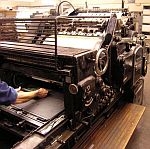 (Host) Lovers of fine books are mourning the demise of a company known world wide for uncompromising quality and design.
(Host) Lovers of fine books are mourning the demise of a company known world wide for uncompromising quality and design.
The Stinehour Press opened its doors on a Northeast Kingdom farm in 1950. Three weeks ago, the owners decided to shut down.
VPR’s Charlotte Albright spoke to some long-time employees in Lunenburg.
(Albright) During his daily lunchtime visit to the press he founded, 83-year-old Roderick Stinehour – known as Rocky – comes across as thoughtful and cautious. Yet in 1950, he took a daring leap and bought this printing shop tucked into a sprawling red farm complex. With his wife and a handful of Dartmouth College friends he grew it into what he called the "print farm," world famous for exquisite scholarly books.
(Stinehour) “I often think of it as the road least taken – Frost’s poem. We took that road.”
(Albright) For Stinehour, making a fine volume is like designing a functional home.
(Stinehour) "It’s architecture, in a way. Everything has to fit together and flow together, and in the making of it you have to, it’s purpose is to be read and utilized by someone without any effort on their part.”
(Albright) The typical Stinehour book – though each is a distinctive gem – features classic typefaces, lots of space on each page, high quality paper and binding, and lustrous color illustrations. But beauty doesn’t come cheap.
Ten years ago, he sold his beloved namesake to an Irish company, which bailed out a few years later. The investors who rescued it say they can’t make the $3 million investment needed to remain competitive. A downcast skeleton crew is finishing up work in progress.
(Sound of press)
(Albright) A slightly outmoded photographic offset press spits out elegant pages for the New York Library. For the past 50 years, a steady parade of other high profile clients – including Robert Frost and photographer Alfred Steiglitz – have strolled through this room.
Early on, Rocky Stinehour’s wife, Elizabeth, served homemade lunches to the crew. Workers helped themselves to the company gas pump on the honor system. And designer Paul Hoffman and Eric Huddleston remember another old-fashioned perq:
(Hoffman) “There was a little pond in the back and in the fall when it would freeze people would go out there and ice skate and shovel it off.”
(Huddleston) “People! More like just you would go out there and skate and shovel it off.”
(Albright) Huddleston doesn’t know where he’ll work now. Hoffman hopes to free-lance book design. Another of Stinehour’s early disciples, Harry Mueller, is now teaching graphics and typography at nearby Lyndon State College. Even eight years ago, when he left as Stinehour’s general manager, he says he couldn’t underbid Chinese printers.
(Mueller) "Try to do fine book publishing and fine book printing in this country right now. It’s a very difficult market.”
(Albright) Current CEO Warren Bingham agrees. But even since handing out the pink slips a few weeks ago, he’s been climbing the stairs almost every day to his attic office, finishing up his "to-do" list and making last-ditch calls to potential investors.
(Bingham) “Sounds like a triumph of hope over reason at this point.”
(Albright) In the meantime, Bingham is trying to find jobs for almost 20 talented designers and printers. Many say, sadly, that they would rather settle for less creative work rather than leave this economically battered yet beautiful corner of Vermont.
For VPR News, I’m Charlotte Albright, in Lunenburg
Photo:Harry Mueller